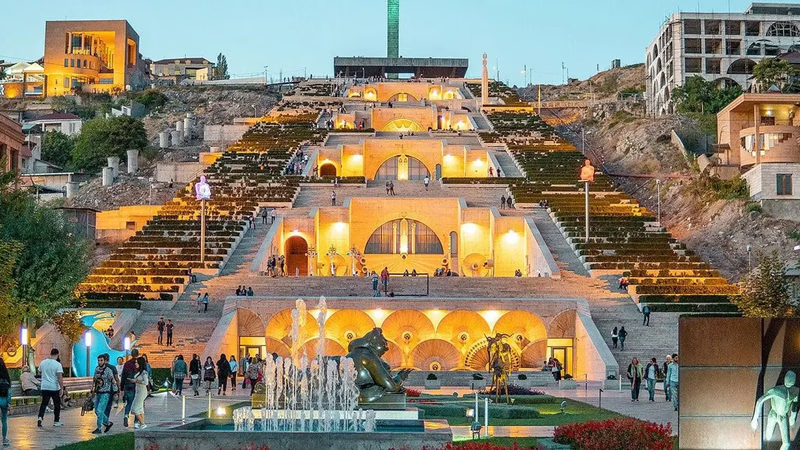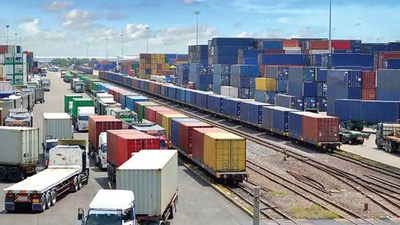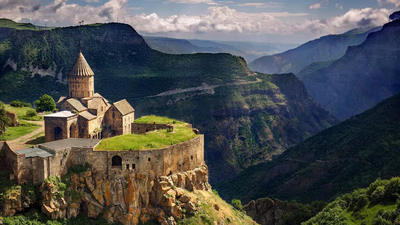
Armenia"s strategic location impacts trade dynamics in the region. "
Armenia is a landlocked country located in the South Caucasus region of Eurasia. Turkey to the west, Georgia to the north, Azerbaijan to the east, and Iran to the south. The country's geography plays a crucial role in shaping its political and economic interactions with its neighbors. Being landlocked limits Armenia's access to seaports, making it heavily dependent on its neighbors for trade routes and transportation.
Armenia's relationship with Azerbaijan is highly complex and marked by a long-standing territorial conflict over the region of Nagorno-Karabakh. The conflict resulted in a full-scale war in the early 1990s, with Armenia and ethnic Armenian forces gaining control over Nagorno-Karabakh and several surrounding regions. The conflict remained unresolved for decades until a major escalation in 2020 led to a ceasefire agreement brokered by Russia. The situation remains fragile, and tensions persist. The closed border between Armenia and Azerbaijan further complicates their relationship.
Armenia has generally maintained positive relations with its northern neighbor, Georgia. The two countries share a border and have collaborated on various economic and infrastructure projects. However, occasional tensions and border disputes have arisen, particularly in the border regions of Javakheti and Samtskhe-Javakheti, where there is a significant Armenian population. Armenia shares a border with Iran to the south. Historically, the two countries have maintained relatively friendly relations, including economic cooperation and cultural exchanges. Iran has served as an important trade partner for Armenia, especially since it provides an alternative route for imports and exports through its ports.
Armenia is located in the South Caucasus, which borders Georgia to the north and the Republic of Azerbaijan to the east. The country is generally divided geographically into three regions: Greater Armenia, Lesser Armenia, and New Armenia. If you look at the history of Armenia, both Greater and Lesser areas, you will remember ancient Armenia. These two lands were separated. Armenia is larger than the other two regions and includes 15 important states. Armenia is a powerful country in terms of industry and income and can include the simplest system, and more than in previous years Armenia has been chosen as a suitable place to live, and this is due to the precise and necessary work environment in Armenia. It was able to provide the best conditions.
Armenia consists of 11 provinces and is one of the countries of the South Caucasus. It is bordered by Georgia to the north and Azerbaijan to the east. The political regime in Armenia is a democratic republic with three independent branches of the executive, the legislature and the judiciary. The main legislative body in Armenia is the National Assembly. As it turns out, the country consists of 131 seats, of which 90 are party members and 41 are in solitary confinement. In general, the existing tasks are divided into three sections: legislation, oversight, performance organization, and parliamentary activities. The presidency holds a vote every five years.
The political situation in Armenia has changed from a republic to a parliament in a certain period of time, as evidenced by the fact that the referendum atmosphere in this country is precisely and routinely defined. The cities of Armenia have each been formed at a specific time in history. The language of Armenia has undergone many changes in its politics. The price of the Armenian dram has changed throughout history.
The political relationships between Armenia and its neighbors have been complex and influenced by a range of factors, including historical conflicts, territorial disputes, and geopolitical interests. Armenia and Turkey share a complicated history, primarily due to the Armenian Genocide in the early 20th century, which resulted in the deaths of a large number of Armenians. The issue of recognizing the Armenian Genocide has been a contentious point between the two countries. Diplomatic relations between Armenia and Turkey have been strained, and the border between the two countries has been closed since 1993.
-

Armenia"s economy, with a GDP of approximately $13. 6 billion, is classified as lower-middle-income. The country is working to enhance its trade relations and diversify its export base, which currently relies heavily on mining, agriculture, and textiles. While Armenia has made progress in the World Bank"s Ease of Doing Business Index, it still ranks lower in the Global Competitiveness Index. Key sectors include chemicals, machinery, and IT, where Armenia has gained recognition for its skilled workforce and growing startup ecosystem. However, regional challenges such as the conflict with Azerbaijan and closed borders with Turkey limit trade opportunities. Despite these hurdles, Armenia has improved its investment climate to attract foreign direct investment (FDI) through regulatory reforms and incentives. Membership in the Eurasian Economic Union (EAEU) offers access to larger markets and preferential trade agreements.
Additionally, Armenia"s Comprehensive Partnership Agreement with the EU aims to strengthen economic ties further. "
-

Armenia"s trade landscape is characterized by its rich mineral resources, particularly copper and molybdenum, which form a significant part of its exports. The country also exports agricultural products like fruits, vegetables, nuts, and dairy items, alongside textiles and jewelry. However, Armenia"s landlocked position poses challenges for expanding trade, particularly with neighboring countries like Turkey and Azerbaijan due to political tensions. This situation has created opportunities for trade with other nations, especially those in the Eurasian Union that enjoy preferential trading terms. Russia stands out as Armenia"s largest trading partner, accounting for nearly 27% of its trade volume. The relationship is bolstered by cultural ties and the benefits of the Eurasian Economic Union. Other notable partners include Switzerland, Bulgaria, Iraq, the Netherlands, China, and Iran. While Armenia imports a variety of goods including energy resources and machinery to support its economy, it often faces a trade deficit where imports surpass exports.
This imbalance necessitates reliance on remittances and foreign investments to sustain economic growth. "
-

Armenia"s economy is classified as an emerging market, with a GDP of approximately $13. 6 billion in 2020. The GDP per capita stands at around $4,500, reflecting lower income levels compared to developed nations. Key sectors include mining, manufacturing, food processing, and construction, with mining being particularly significant due to the country"s rich mineral resources. Remittances from Armenians abroad contribute substantially to national income. Foreign direct investment from countries like Russia and the U. S. supports sectors such as IT and tourism.
Despite challenges post-independence, Armenia has seen growth in various industries, including tourism which attracts visitors from neighboring Iran. The agricultural sector employs about 44% of the workforce but has seen a decline in its GDP contribution over time. The services sector is also vital, encompassing IT, financial services, and telecommunications. Armenia"s economic stability is supported by controlled inflation since 1998 and a free market system aided by international organizations. Taxation on income and corporate profits serves as a key revenue source for the government. "
-

Armenia"s primary trading partner is Russia, which supplies a significant portion of its imports, including natural gas, petroleum products, and machinery. As a member of the Eurasian Economic Union (EAEU), Armenia benefits from preferential trade agreements with Russia. China has emerged as an increasingly vital partner, providing machinery, electronics, textiles, and raw materials that support Armenia"s manufacturing and retail sectors. Germany is another key player in Armenia"s import market, known for high-quality machinery and industrial equipment. Iran also plays a crucial role by supplying energy resources and various consumer goods. The European Union (EU) has strengthened its ties with Armenia through the Comprehensive and Enhanced Partnership Agreement (CEPA), focusing on mutual interests such as economic development and reform support. Despite political tensions with Turkey, some trade continues in construction materials and textiles. The United States contributes to Armenia"s imports through technology and pharmaceuticals. Overall, Armenia maintains diverse trade relations with multiple countries to meet its import needs.
-

Armenia, a landlocked country in the South Caucasus, is bordered by Turkey, Georgia, Azerbaijan, and Iran. Its geography significantly impacts its political and economic relations. The ongoing territorial conflict with Azerbaijan over Nagorno-Karabakh has created a complex relationship, exacerbated by a closed border. Armenia maintains generally positive ties with Georgia, collaborating on various projects despite occasional tensions. Relations with Iran are historically friendly, providing Armenia with vital trade routes. The country is divided into three regions: Greater Armenia, Lesser Armenia, and New Armenia. Politically, Armenia operates as a democratic republic with a National Assembly comprising 131 seats. The political landscape has evolved over time, reflecting changes in governance and public sentiment.
Historical conflicts and geopolitical interests shape Armenia"s interactions with its neighbors, particularly with Turkey due to the contentious issue of the Armenian Genocide. Diplomatic relations remain strained as borders have been closed since 1993. "
-

Armenia"s trade landscape is characterized by strong ties with Russia, China, and the EU, particularly Germany. As a member of the Eurasian Economic Union (EAEU), Armenia benefits from preferential trade agreements with Russia, importing natural gas, machinery, and consumer goods. China has emerged as a vital partner, supplying machinery and textiles that support Armenia"s manufacturing and retail sectors. The EU also plays a significant role in Armenia"s imports, with countries like Germany and Italy providing essential goods. Additionally, Armenia maintains trade relations with nations such as Ukraine, South Korea, and India. The country"s economic growth is bolstered by its focus on industrial development and agricultural products. Despite political tensions with Turkey, some trade continues in construction materials and textiles. The United States has become increasingly important for technology and pharmaceuticals.
Overall, Armenia"s strategic partnerships enhance its economic prospects while fostering regional trade dynamics. "






